
 Kandinsky,
Wassily
Kandinsky,
Wassily
 Kandinsky, Wassily,
Russian in full VASILY VASILYEVICH KANDINSKY (b. Dec. 4 [Dec. 16, New Style],
1866, Moscow, Russia--d. Dec. 13, 1944, Neuilly-sur-Seine, Fr.), Russian-born
artist, one of the first creators of pure ab straction in modern painting. After
successful avant-garde exhibitions, he founded the influential Munich group Der
Blaue Reiter (The Blue Rider; 1911-14) and began completely
abstract painting. His forms evolved from fluid and organic to geometric and,
finally, to pictographic ( e.g., Tempered Élan, 1944).
Kandinsky, Wassily,
Russian in full VASILY VASILYEVICH KANDINSKY (b. Dec. 4 [Dec. 16, New Style],
1866, Moscow, Russia--d. Dec. 13, 1944, Neuilly-sur-Seine, Fr.), Russian-born
artist, one of the first creators of pure ab straction in modern painting. After
successful avant-garde exhibitions, he founded the influential Munich group Der
Blaue Reiter (The Blue Rider; 1911-14) and began completely
abstract painting. His forms evolved from fluid and organic to geometric and,
finally, to pictographic ( e.g., Tempered Élan, 1944).
Kandinsky, himself an accomplished musician, once said ``Color is the keyboard,
the eyes are the harmonies, the soul is the piano with many strings. The artist
is the hand that plays, touching one key or another, to cause vibrations in the
soul.'' The concept that color and musical harmony are linked has a long
history, intriguing scientists such as Sir Isaac Newton. Kandinsky used color in
a highly theoretical way associating tone with timbre (the sound's character),
hue with pitch, and saturation with the volume of sound. He even claimed that
when he saw color he heard music.
The Kandinsky pages were contributed by Steven Brock.
See also: Mark Harden's review of Kandinsky's Compositions at Atlantis Art reviews.
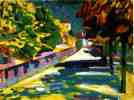 Autumn in Bavaria
Autumn in Bavaria
1908; Oil on cardboard,
33x45cm; Centre Georges Pompidou, Paris
 Improvisation 7
Improvisation 7
1910 (180 Kb); Oil on canvas,
131 x 97 cm; Tretyakov Gallery, Moscow
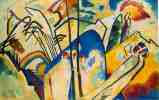 Composition IV
Composition IV
1911 (170 Kb); Oil on canvas,
159.5 x 250.5 cm (62 7/8 x 98 5/8 in); Kunstsammlung Nordrhein-Westfallen,
Dusseldorf
 Composition V
Composition V
1911 (170 Kb); Oil on canvas,
190 x 275 cm (6' 3 7/8" x 9' 1/4"); Private collection
 Black Spot I
Black Spot I
1912 (200 Kb); Oil on canvas, 100
x 130 cm; The Hermitage, St. Petersburg
 Improvisation 31 (Sea Battle)
Improvisation 31 (Sea Battle)
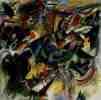 Ravine Improvisation
Ravine Improvisation
1914 (110 Kb); Oil on cardboard, 110 x
110 cm; Stadtische, Munich
``Ravine'' is so coarse that, intuitively, I feel the title is wrong. It is
the one given, however. And of course, the chaotic bric-à-brac image of a
ravine does mesh with the Kandinsky spirit--so, away with the intuitive!''
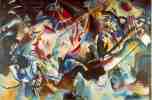 Composition VI
Composition VI
1913 (170 Kb); Oil on canvas,
195 x 300 cm (6' 4 3/4" x 10'); Hermitage Museum, St. Petersburg
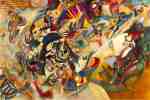 Composition VII
Composition VII
1913 (200 Kb); Oil on canvas,
200 x 300 cm (6' 6 3/4" x 9' 11 1/8"); Tretyakov Gallery, Moscow
 Small Pleasures
Small Pleasures
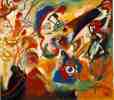 Fragment 2 for Composition VII
Fragment 2 for Composition VII
1913 (180 Kb);
Oil on canvas, 87.5 x 99.5 cm (34 1/2 x 39 1/4 in); Albright-Knox Art Gallery,
Buffalo, NY
 On White II
On White II
1923; Oil on canvas, 105 x 98cm;
Centre Georges Pompidou, Paris
 Composition VIII
Composition VIII
1923 (140 Kb); Oil on canvas,
140 x 201 cm (55 1/8 x 79 1/8 in); Solomon R. Guggenheim Museum, New York
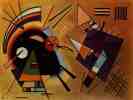 Black and Violet
Black and Violet
1923
(thanks to Michael Shephard)
 Contrasting Sounds
Contrasting Sounds
1924; Oil on cardboard,
70x49.5cm; Centre Georges Pompidou, Paris
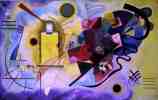 Yellow, Red, Blue
Yellow, Red, Blue
1925; Oil on canvas,
127x200cm; Centre Georges Pompidou, Paris
 Composition IX
Composition IX
1936 (120 Kb); Oil on canvas,
113.5 x 195 cm (44 5/8 x 76 3/4 in); Musee National d'Art Moderne, Centre
Georges Pompidou, Paris
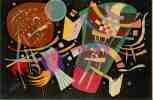 Composition X
Composition X
1939 (160 Kb); Oil on canvas,
130 x 195 cm (51 1/8 x 76 3/4 in); Kunstsammlung Nordrhein-Westfalen,
Dusseldorf
Biography
Born in Moscow in 1866, Kandinsky spent his early childhood in
Odessa. His parents played the piano and the zither and Kandinsky himself
learned the piano and cello at an early age. The influence of music in his
paintings cannot be overstated, down to the names of his paintings
Improvisations, Impressions, and
Compositions. In 1886, he enrolled at the University of Moscow,
chose to study law and economics, and after passing his examinations, lectured
at the Moscow Faculty of Law. He enjoyed success not only as a teacher but also
wrote extensively on spirituality, a subject that remained of great interest and
ultimately exerted substantial influence in his work. In 1895 Kandinsky attended
a French Impressionist exhibition where he saw Monet's Haystacks
at Giverny. He stated, "It was from the catalog I learned this was a
haystack. I was upset I had not recognized it. I also thought the painter had no
right to paint in such an imprecise fashion. Dimly I was aware too that the
object did not appear in the picture..." Soon thereafter, at the age of thirty,
Kandinsky left Moscow and went to Munich to study life-drawing, sketching and
anatomy, regarded then as basic for an artistic education.
Ironically, Kandinsky's work moved in a direction that was of much greater
abstraction than that which was pioneered by the Impressionists. It was not long
before his talent surpassed the constraints of art school and he began exploring
his own ideas of painting - "I applied streaks and blobs of colors onto the
canvas with a palette knife and I made them sing with all the intensity I
could..." Now considered to be the founder of abstract art, his work was
exhibited throughout Europe from 1903 onwards, and often caused controversy
among the public, the art critics, and his contemporaries. An active participant
in several of the most influential and controversial art movements of the 20th
century, among them the Blue Rider which he founded along with Franz Marc and the Bauhaus
which also attracted Klee, Lyonel Feininger
(1871-1956), and Schonberg, Kandinsky continued to further express and define
his form of art, both on canvas and in his theoretical writings. His reputation
became firmly established in the United State s through numerous exhbitions and
his work was introduced to Solomon Guggenheim, who became one of his most
enthusiastic supporters.
In 1933, Kandinsky left Germany and settled near Paris, in Neuilly. The
paintings from these later years were again the subject of controversy. Though
out of favor with many of the patriarchs of Paris's artistic community, younger
artists admired Kandinsky. His studio was visited regularly by Miro, Arp,
Magnelli and Sophie Tauber.
Kandinsky continued painting almost until his death in June, 1944. his
unrelenting quest for new forms which carried him to the very extremes of
geometric abstraction have provided us with an unparalleled collection of
abstract art.
© 1 Jan 1996, Nicolas Pioch
Thanks to the BMW Foundation, the
WebMuseum mirrors, partners and
contributors for their support.
 Kandinsky, Wassily,
Russian in full VASILY VASILYEVICH KANDINSKY (b. Dec. 4 [Dec. 16, New Style],
1866, Moscow, Russia--d. Dec. 13, 1944, Neuilly-sur-Seine, Fr.), Russian-born
artist, one of the first creators of pure ab straction in modern painting. After
successful avant-garde exhibitions, he founded the influential Munich group Der
Blaue Reiter (The Blue Rider; 1911-14) and began completely
abstract painting. His forms evolved from fluid and organic to geometric and,
finally, to pictographic ( e.g., Tempered Élan, 1944).
Kandinsky, Wassily,
Russian in full VASILY VASILYEVICH KANDINSKY (b. Dec. 4 [Dec. 16, New Style],
1866, Moscow, Russia--d. Dec. 13, 1944, Neuilly-sur-Seine, Fr.), Russian-born
artist, one of the first creators of pure ab straction in modern painting. After
successful avant-garde exhibitions, he founded the influential Munich group Der
Blaue Reiter (The Blue Rider; 1911-14) and began completely
abstract painting. His forms evolved from fluid and organic to geometric and,
finally, to pictographic ( e.g., Tempered Élan, 1944).
 Autumn in Bavaria
Autumn in Bavaria  Improvisation 7
Improvisation 7  Composition IV
Composition IV  Composition V
Composition V  Black Spot I
Black Spot I  Ravine Improvisation
Ravine Improvisation  Composition VI
Composition VI  Composition VII
Composition VII  Fragment 2 for Composition VII
Fragment 2 for Composition VII  On White II
On White II  Composition VIII
Composition VIII  Black and Violet
Black and Violet  Contrasting Sounds
Contrasting Sounds  Yellow, Red, Blue
Yellow, Red, Blue  Composition IX
Composition IX  Composition X
Composition X